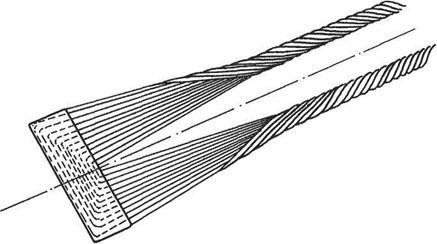The trailing vortex system
The pressure on the upper surface of a lifting wing is lower than that of the surrounding atmosphere, while the pressure on the lower surface is greater than that on the upper surface, and may be greater than that of the surrounding atmosphere. Thus, over the upper surface, air will tend to flow inwards towards the root from the tips, being replaced by air that was originally outboard of the tips. Similarly, on the undersurface air will either tend to flow inwards to a lesser extent, or may tend to flow outwards. Where these two streams combine at the trailing edge, the difference in spanwise velocity will cause the air to roll up into a number of small streamwise vortices, distributed along the whole span. These small vortices roll up into two large vortices just inboard of the wing-tips. This is illustrated in Fig. 5.3. The strength of
|
Fig. 5.3 The horseshoe vortex |
each of these two vortices will equal the strength of the vortex replacing the wing itself.
The existence of the trailing and starting vortices may easily be verified visually. When a fast aeroplane pulls out of a dive in humid air the reduction of pressure and temperature at the centres of the trailing vortices is often sufficient to cause some of the water vapour to condense into droplets, which are seen as a thin streamer for a short distance behind each wing-tip (see frontispiece).
To see the starting vortex all that is needed is a tub of water and a small piece of board, or even a hand. If the board is placed upright into the water cutting the surface and then suddenly moved through the water at a moderate incidence, an eddy will be seen to leave the rear, and move forwards and away from the ‘wing’. This is the starting vortex, and its movement is induced by the circulation round the plate.












